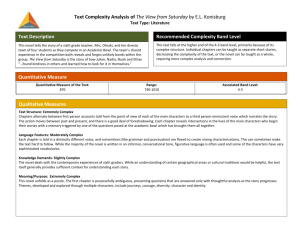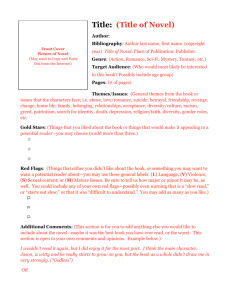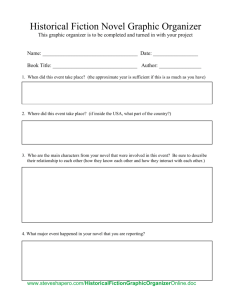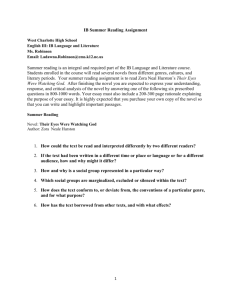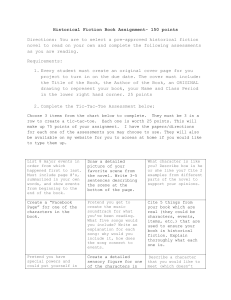Text Complexity Analysis of Seedfolks
advertisement
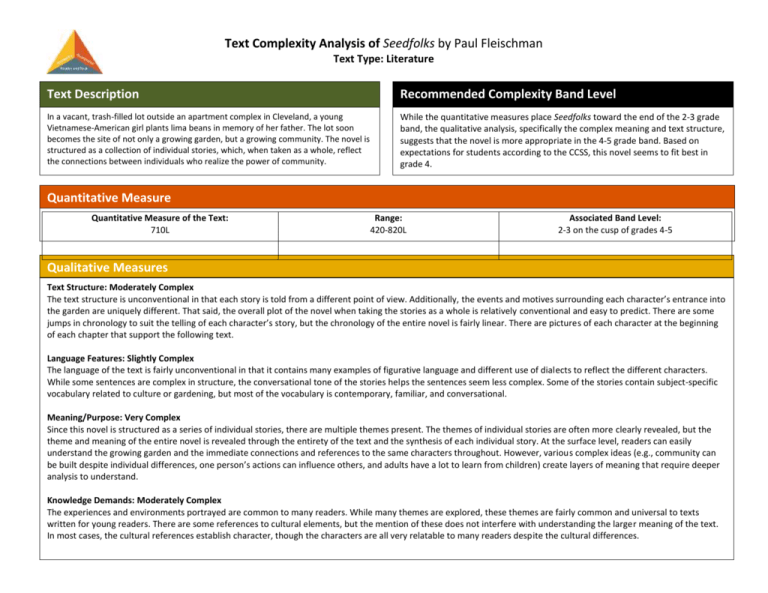
Text Complexity Analysis of Seedfolks by Paul Fleischman Text Type: Literature Text Description Recommended Complexity Band Level In a vacant, trash-filled lot outside an apartment complex in Cleveland, a young Vietnamese-American girl plants lima beans in memory of her father. The lot soon becomes the site of not only a growing garden, but a growing community. The novel is structured as a collection of individual stories, which, when taken as a whole, reflect the connections between individuals who realize the power of community. While the quantitative measures place Seedfolks toward the end of the 2-3 grade band, the qualitative analysis, specifically the complex meaning and text structure, suggests that the novel is more appropriate in the 4-5 grade band. Based on expectations for students according to the CCSS, this novel seems to fit best in grade 4. Quantitative Measure Quantitative Measure of the Text: 710L Range: 420-820L Associated Band Level: 2-3 on the cusp of grades 4-5 Qualitative Measures Text Structure: Moderately Complex The text structure is unconventional in that each story is told from a different point of view. Additionally, the events and motives surrounding each character’s entrance into the garden are uniquely different. That said, the overall plot of the novel when taking the stories as a whole is relatively conventional and easy to predict. There are some jumps in chronology to suit the telling of each character’s story, but the chronology of the entire novel is fairly linear. There are pictures of each character at the beginning of each chapter that support the following text. Language Features: Slightly Complex The language of the text is fairly unconventional in that it contains many examples of figurative language and different use of dialects to reflect the different characters. While some sentences are complex in structure, the conversational tone of the stories helps the sentences seem less complex. Some of the stories contain subject-specific vocabulary related to culture or gardening, but most of the vocabulary is contemporary, familiar, and conversational. Meaning/Purpose: Very Complex Since this novel is structured as a series of individual stories, there are multiple themes present. The themes of individual stories are often more clearly revealed, but the theme and meaning of the entire novel is revealed through the entirety of the text and the synthesis of each individual story. At the surface level, readers can easily understand the growing garden and the immediate connections and references to the same characters throughout. However, various complex ideas (e.g., community can be built despite individual differences, one person’s actions can influence others, and adults have a lot to learn from children) create layers of meaning that require deeper analysis to understand. Knowledge Demands: Moderately Complex The experiences and environments portrayed are common to many readers. While many themes are explored, these themes are fairly common and universal to texts written for young readers. There are some references to cultural elements, but the mention of these does not interfere with understanding the larger meaning of the text. In most cases, the cultural references establish character, though the characters are all very relatable to many readers despite the cultural differences. Text Complexity Analysis of Seedfolks by Paul Fleischman Text Type: Literature Considerations for Reader and Task Possible Major Instructional Areas of Focus (include 3-4 CCS Standards) for this Text: Below are factors to consider with respect to the reader and task: Potential Challenges this Text Poses: RL.5.2 - Determine the theme of a story, drama, or poem from details in the text, including how characters in a story or drama respond to challenges or how the speaker in a poem reflects upon a topic; summarize the text. Have each student trace the actions of one character from the beginning to the end of the novel. In small groups, have students use these maps to determine the theme of the text through class discussion. Focus on the author’s lesson or message based on character actions. RL.5.3 - Compare and contrast two or more characters, settings, or events in a story or drama, drawing on specific details in the text (e.g., how characters interact). Compare how two characters came to work in the garden. Have students share their comparisons and create a visual map of the connections between the various characters. RL.5.5 - Explain how a series of chapters, scenes, or stanzas fit together to provide the overall structure of a particular story, drama, or poem. Trace the chain of Kim’s actions from the beginning of the novel until the end throughout each chapter (focusing on cause and effect for her character). L.5.3b - Use knowledge of language and its conventions when writing, speaking, reading, or listening; Compare and contrast the varieties of English (e.g., dialects, registers) used in stories, dramas, or poems. Discuss the different “voices” of each character by focusing on how the author varies vocabulary and syntax from one character to the next. Some of the cultural references may cause trouble for students, but the gist of each story is not overly dependent on the specifics of the cultural references. The somewhat unconventional structure could also create some challenge for students who are not immediately capable of seeing connections or trace an idea across different contexts and plots. Differentiation/Supports for Students: Encourage students who are struggling with keeping track of the various connections and plots to create visual maps of the connections. For learning extension: Consider engaging students in a service learning project designed at building their own community garden (there are many online resources and networks that support community garden creation). Have them journal about their experiences throughout and then create their own class collection of stories as a summation of their experience (W.5.3a-e).


